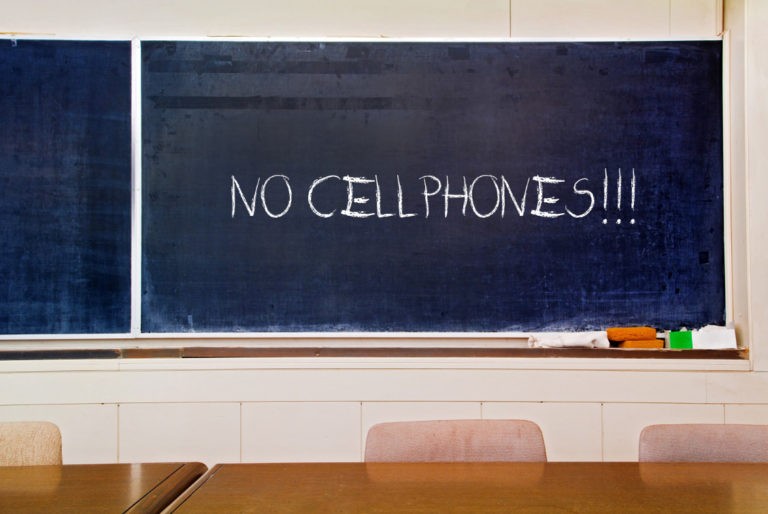There is no doubt that most school-age students are extremely tech savvy and used to being connected to a device during any downtime. In fact, a report by Common Sense Media showed that half of the teens surveyed acknowledged an addiction to cell phone usage. With this understanding, it is easy to see why students struggle to go the entire school day without checking their phone constantly. Teachers and administrators are left with the responsibility to keep students off their cell phones and engaged in classwork.
The Importance of Keeping Students Off Cell Phones in Class
While many students need a cell phone to communicate with their family during after-school hours, there are many reasons why students should not be allowed to use their handheld devices during the school day. First and foremost, a child on their phone is not attentive to the instruction. Having a policy that limits cell phone use can eliminate such distractions and help improve student focus.
Because most cell phones are equipped with internet access, students can easily look up answers and possibly cheat on assignments and tests. In similar ways, they can snap pictures of test items, share answers, and otherwise use them in inappropriate manners. Because the school is responsible for what occurs on school property, it is even more important for educators to limit student access to their phones during the school day.
Ways to Keep Students Off Their Cell Phones in Class
It is easy to say students should not be on their cell phones at school, but it is much harder to prevent these tech savvy adolescents from accessing their data. Many schools are going to a ‘no cell phone’ policy, leaving teachers with the responsibility of coming up with ways to carry out it out. Here are five ways to prevent student use of cell phones in class:
Provide a Cell Phone Agreement
When parents and students know the expectations and consequences, they may be more likely to follow the guidelines. The school may have a policy saying students cannot have their phones in use in class, but it might be up to the teacher to create a policy for their own classroom.
Teachers may allow students to provide input into such guidelines. They can help determine if phones should be kept out of reach of students during class time (i.e. in a see-through shoe rack, calculator caddy, pocket chart, etc.) or if students should be allowed to turn them off and leave them upright on their desk during class so the phone is still in view for the child, but visibly not in use for the teacher. Together the teacher and students can establish what approach is preferred, how it will be used, and what will happen if rules are broken.
The teacher should also make sure consequences are followed or the entire policy will be useless. Students are more likely to adhere to the policy if they have had input in making it. Having students and parents sign this agreement adds extra accountability to the policy.
Keep Students Engaged
When students are not engaged, they are more likely to resort to the need for phone interaction. For this reason, teachers should plan appealing activities that incorporate experiments, cooperative learning, and other creative activities to teach standards. When students are allowed to interact with one another, they will build social and communication skills and forget the need to check their phone.
Utilize Positive Reinforcement
As humans, we all work harder for incentives. Students may already earn points for answering or asking questions, turning in homework on time, or for class attendance. Why not add cell phones to this list? Students could earn points or extra credit for keeping their phone in the proper location. Once the device is checked in, the student earns a point. In order for this to work, as with any point system, prizes will need to be meaningful to the students.
Use Technology as a Substitute
Some might recommend cellphone use as long as it is under direction of a teacher and tied to a curriculum. If we are being honest, we will realize that students will still manage to text and tweet without teacher knowledge. In addition, if the school has a ‘no phone use’ policy and the teacher allows it for certain activities, they are also teaching students it is okay to break the rules.
Instead, teachers can easily use technology to substitute phone usage. Students often enjoy using clicker devices to play whole-class interactive games. Students may also work independently, at their own learning level, on curriculum-based game sites online. Teachers may also utilize whole-class technology through engaging subject-related videos or slide decks. These ideas will help give students their media fix without the use of their cell phones.
Be Active
First, the teacher should actively walk around the classroom. When a teacher is on the move, students will have less of an opportunity to pull out their phone. As you walk around, you may be monitoring schoolwork, but you can also glance in desks, look for earbuds being used, or notice if students appear to be using a phone instead of doing their assigned tasks.
In addition to the teacher being active, students should be allowed time to be active as well. We all get tired of sitting, and class activity does not have to mean loud and out of control. Having students participate in a stand-up/sit-down activity to reinforce the standard, participate in a brain break through yoga, or even move to different corners of the room depending on their answer to a question allows controlled movement and helps eliminate the chance students have to get on their phones.
There are many ways to keep students involved and off their phones. It is getting harder as new technology, such as smart watches, which are tied to phones, become more available. Still, teachers can keep students actively involved if they are willing to get creative and provide engaging activities.




